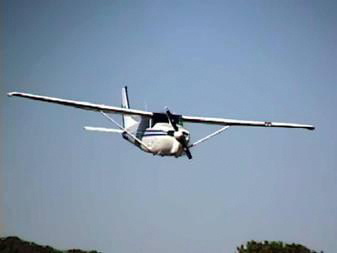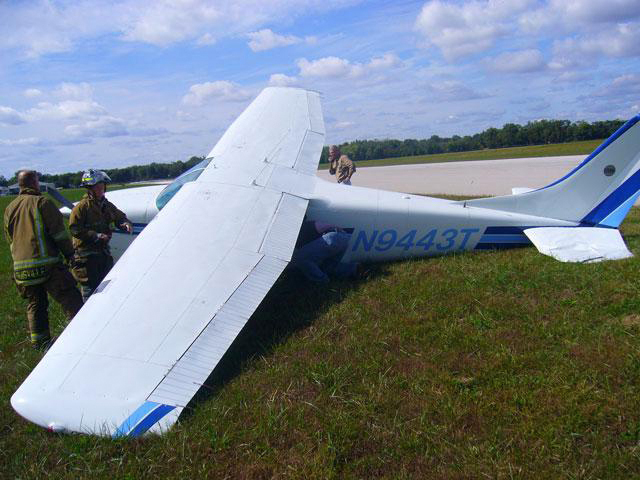As I write this, an old friend lies injured, awaiting help. She’s a beautiful old Cessna 210, a small, retractable gear airplane that I’ve flown for over 25 years. This old gal used to be part of our family, but passed into the hands of a friend some years ago. Even so, I have enjoyed the continued privilege of flying and teaching in this fine aircraft ever since. I’m sorry to report that I had no choice but to crash land her some days ago.
I arrived at Bowman Airport shortly before 9:00AM to perform a Biennial Flight Review and Instrument Competency Check for David in his father’s Cessna 210. After completing the required ground instruction, we were ready for departure shortly after 10:00AM.
David is an accomplished pilot; he’s an ex-fighter jock for the Navy and used to fly F-18’s out of Charleston, South Carolina, but David has been retired from the military for some years. He and his dad fly the 210 for business and for fun.
Take off was uneventful. We loitered over the designated practice area in Oldham County for part of the flight review and instrument work before practicing some holding patterns over Nabb, Indiana, some instrument approaches both at Madison and at Clark County Airport, and then some landings. We cycled the landing gear several times during the flight without incident. The flaps were also cycled several times without incident.
After finishing the air work, I praised David for a job well done and asked him to fly us back to home base where I would sign his logbook endorsements. We headed back to Louisville and were cleared for landing on Runway 24. When David tried to lower the wheels, the gear-up light went out, but the gear-down light never came on. No wheels were visible from the side windows. David asked, “Is this part of the test? Did you pull the gear circuit breaker?” “Sorry, David, but no.”
We contacted the tower to let them know of our difficulty and were directed to orbit the area south of the airport while we worked on the problem. The circuit breaker for the landing gear checked OK. A quick check of the flaps, which are also hydraulically actuated, showed them to be non-functional, clearly implicating the hydraulic system as the source of the problem.
The hydraulic system on this airplane has a manual backup pump, with a reserve of hydraulic fluid in case of failure; I pumped the manual gear extension lever for many minutes but without response.
We did a low pass of the tower for visual inspection of the gear. Simultaneously, I was also able to see the profile shadow of the underbody of the aircraft as we flew by. The nose gear was visible, partially extended. The main gear doors were partly open, and the left main was partly visible, possibly very slightly extended.
 After many more minutes of unsuccessful attempts at lowering the gear, we declared an emergency and asked for the fire trucks and Emergency Medical Services. Since I had not yet signed off David’s log books, I was the only authorized Pilot in Command. I took over the controls from the right seat, and continued to orbit south of the field while waiting. David cleaned up the cockpit of loose items and stowed them on the floor behind us. Even a loose pen in a crash can pierce an artery. Emergency services arrived; I told the tower we were ready.
After many more minutes of unsuccessful attempts at lowering the gear, we declared an emergency and asked for the fire trucks and Emergency Medical Services. Since I had not yet signed off David’s log books, I was the only authorized Pilot in Command. I took over the controls from the right seat, and continued to orbit south of the field while waiting. David cleaned up the cockpit of loose items and stowed them on the floor behind us. Even a loose pen in a crash can pierce an artery. Emergency services arrived; I told the tower we were ready.
I did a no flaps approach keeping the nose high and approaching at minimum safe speed. This can be a bit tricky because usually, flaps would allow the aircraft to be flown safely at a slower speed. Fly too slowly, especially without flaps, and the aircraft could fall out of the sky, spinning out of control towards the ground. A quarter mile from touchdown, the trajectory looked just a little high. I needed to put the plane into a slip. This would angle the aircraft a bit to the side, increase drag on the airframe and steepen the descent. Normally, the flaps would have taken care of this requirement. Carefully crossing the controls to create a forward slip for about five seconds increased our rate of descent—the glide angle looked perfect.
The edge of the field began streaming below us, trees, then grass, then the runway threshold; only seconds remained before ground contact. Just before touchdown, I gave David the OK to pull the mixture control to full lean, starving the engine of fuel. He then switched off the magnetos.
Touchdown was imminent, but the propeller had stopped in a nearly vertical position. I asked David to use the starter motor to bump the propeller to a more horizontal position to keep it from striking the ground. This would minimize damage to prop and engine. Afterwards, we turned off the master switch for the electrical system and shut off the fuel valve to reduce the chance of fire.
Contact! As we scraped down the runway, the partially open gear doors and folded mains tried to drag the aircraft hard to the left. Strong application of right rudder and manipulation of the ailerons kept the plane under control and straight down the centerline until the aircraft slowed to where aerodynamic controls became ineffective. The aircraft then gently veered off into the grass on the left side of the runway and stopped, leaning to the left with some of the weight supported on the horizontal stabilizer and wing tip. I exhaled sharply and smiled—the grass was a good place to park.
With all systems shut down, we exited via the left door. Immediately, the emergency crew was upon us. The crew chief asked, “Who was the pilot?” I slowly lifted my hand to shoulder level. A big grin burst onto his face. “That was amazing! You guys did a hell of a good job.” A moment later, the chief’s cell phone rang. “It’s the Control Tower. They want to talk to you.”
I have taught flying long enough to know it’s almost never good when the tower wants to talk to the pilot. With student pilots, they can be somewhat forgiving, but in any case, it usually means trouble. With just a touch of hesitation, I took the phone. “Larry Preble, here.” “Are you the pilot?” “Yes ...” “Well, I’ve been working this tower for many years. I just wanted to say, that is the best belly landing I’ve ever seen! Great job.” With that, my trepidation melted. “Thanks.”

The damage to the plane was minimal, some scraping on the gear doors, some damage to the left horizontal stabilizer, but eminently repairable. The propeller, and therefore the engine, had been spared.
Next was a flurry of phone conversations; the NTSB wanted to hear the details. The FAA wanted information and would be sending inspectors. Then, David’s parents arrived. I fixed my gaze on their eyes, wondering what their reaction would be—I had just crashed their plane. His mom came over and gave me a big hug. They were both relieved we were OK.
A large wrecker eventually arrived and picked up the plane in a sling. Then, father and son yanked, and pulled, until the gear locked into place. There was so little damage, a crew was able to tow the plane on its own wheels, and then back the Cessna into the hangar.
The next day, seven FAA inspectors arrived. Two were senior inspectors, the other five were trainees. It’s always a tense moment when dealing with the FAA. Whenever there is an accident to investigate, part of their job is to find out who to blame.
They removed the cowling and probed up into the undercarriage and hydraulic system. At last, they found it; there was a broken steel hydraulic line, a classic case of metal fatigue. This line was buried deep in the system, unable to be seen on preflight inspection. In any case, the line would have appeared normal until it failed. They manipulated the manual hydraulic pump lever and watched as the remnants of red fluid spurted from the broken line. That meant that David and I were off the hook.
Now, my old friend is waiting for a response from the insurance company to see if her repairs will be covered. It is common for insurance to pay out a lump sum and then sell a plane for scrap. But this old gal is a friend. The airplane doctors tell us she would not be hard to fix. With a few new parts here and there and a replacement hydraulic system, she would be as good as new. I went by the hangar yesterday. There she lay, waiting. As I watched, a drop of red hydraulic fluid from her belly spattered on the hangar floor. For all appearances, she was still bleeding. I gave her a little pat on the cowling. Pull through ol’ gal, pull through.
Larry Preble
October 11, 2009
 Tuesday, March 25, 2014 at 8:08AM
Tuesday, March 25, 2014 at 8:08AM 

